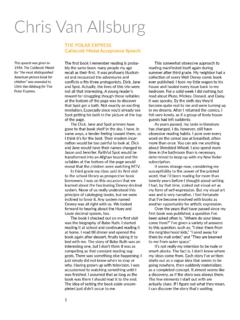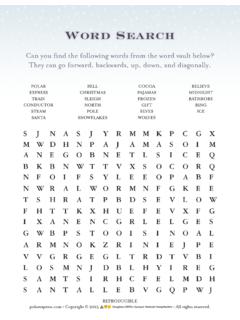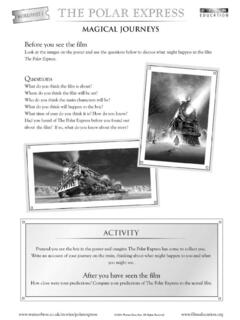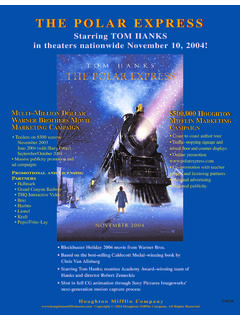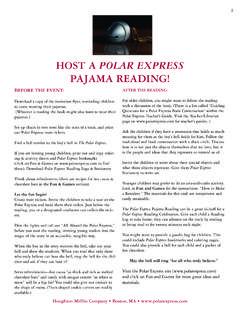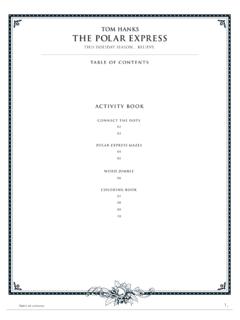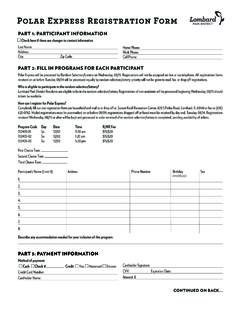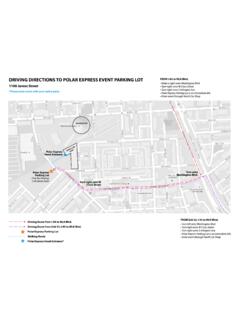Transcription of Sound for The Polar Express Issue 37
1 Thanks to the incredible success of Shrek, Finding Nemo et al, animation is the new vehicle upon which film studios are pre-senting their blockbusters. And, much like f lesh and blood blockbusters, The Polar Express has had an obscene amount of money sunk into its production (upwards of US$150m depending on who you talk to). A big chunk of that cash has gone into the much-touted motion capture animation technique, but thank-fully not all. Director Robert Zemeckis is very particular about his audio and as a result recruited Skywalker Sound and respected Sound designer/re-recording mixer Randy Thom a stalwart member of the LucasFilm team since 1979. The appointment of Thom paid off.
2 As a result, the images and sounds never compete; they only compliment each other. Bob Zemeckis always has enough confidence in the story that he s telling so he doesn t have to fire all of his Sound ammunition at once, Thom explains. When directors are feeling insecure about their film, they often think that the way to keep the audience interested is to have lots of music, lots of dialogue, and lots of Sound effects all of the time. Very often they wind up competing with each other and if you re not careful, you end up with a wall of noise that s inco-herent and doesn t really help the story. Sound for The remarkable technology of motion capture has made The Polar Express a must-see, but it s the film s thoughtful Sound design that makes it a must-hear.
3 Strother Bullins talks to Sound Designer and Re-recording Mixer Randy Thom of Sk y walker Sound about the sounds behind the film s vivid Polar Express44 From Silence to a RoarThe film s beginning utilises large sections of relative silence interspersed with significant bell-like sounds embedded within the soundtrack ref lecting the boy s desperation to hear the bells of Santa s sleigh. Zemeckis and I knew that we wanted to play with this idea of bells and ringing metal, making it a kind of motif that we weave throughout the movie, tells Thom. Another great thing about working with Zemeckis is that he pays attention to what the characters in his stories hear, which is a wonderful thing for me.
4 The clock that s ticking next to the boy s bed develops a bell-like quality, becomes reverberant, and then its ticking disappears completely. Then there s absolute silence in the room until he hears a faint rumbling, and things in the room start to rattle and ring. Again, some of the rattles have a metallic, bell-like Sound . One happens to be a hub cap that he s collected and is leaning against a radiator, so we have fun with tricking the little boy that the hub cap rattling may be a sleigh bell, and this rumbling Sound might be the approaching sleigh. Silence is a fine sonic introduction for the train, which is introduced as a low rumble in the distance and builds to a cacophonou s, yet musical roar.
5 Because the majority of the film takes place on board The Polar Express ; recording, perfect-ing, and controlling the sounds of the train, says Thom, was the film s biggest challenge. Having read the script, I knew that three quarters of the film takes place on The Polar Express , and significant stretches in certain scenes would be solely what we would hear from the train. We had to make the train a character with Sound give it a complex Sound that would change from moment to moment while always making it appear real. Easing Inevitable EditsAcknowledging the way current films are constantly changing via edits throughout production, Thom devised a plan to record train sounds to allow for easier audio adjustments by simply changing a Midi tempo map.
6 These days, a film continues to be re-edited until it s dragged out of the direc-tor s and editors fingers, Thom muses. So, in the Sound department, we have to figure out how to best organise our work. That organisation should allow the f lexibility of freely moving the sounds around to stay in sync with the ever-changing picture. After finding two suitable locomotives that suited his needs one in the California Sierra foothills and one in Michigan Thom and his location recording team ventured out to record train sounds in a unique manner. Keeping things in sync when you re dealing with something like a moving train is tough. There s a continuous Sound , but there are sounds that are changing dynamically all the time.
7 So, very early on, I decided the best way to deal with this potentially huge headache would be to record each element of the train separately. We made sure that we miked the chugs or chuffs, the steam sounds, and the sounds of the wheels on the tracks, all as separately as possible. That way, we had these building blocks and could manufacture the sounds of the train, while still using real sounds. Thom used his favourite location setup a pair of Schoeps CCM miniature microphones in an M/S stereo configuration, recorded directly to a Zaxcom Deva digital location recorder for this labour-intensive task. For the M mic, I used a wide cardioid, and, of course, a figure-eight for the S, explains Thom.
8 I started using M/S a long time ago, mainly because it was much easier to get an M/S stereo setup in one shock-mounted and windscreened zeppelin , and put it in a smaller package. When you re doing things like jumping on and off moving trains, the smaller the recording package is, the better! Once recorded, Thom could easily handle any and all changes prompted by picture edits. We could feed our sounds into a sampler, which would allow us to play the sounds individually, he recalls. When the picture changed and it constantly did throughout post-production or if we needed to change the rate of accel-eration or de-acceleration of the train, all we had to do was change the tempo map of the Midi.
9 It was automatic. According to Thom, this method of location recording saved lots of time, money, and manpower. We did this instead of bringing in a dozen Sound editors to cut in each individual chug to make the acceleration rate happen, he explains. If we had simply gone out and recorded a train moving, it would ve made it very tough to adjust things. Making the Train Sing To enhance the train s sonic realism and to further incorporate the film s bell motif within the soundtrack, Thom made the train sing and breathe via sheet metal, orchestral bows and his own breath. Bob [Zemeckis] wanted the train to seem as alive as possible, explains Thom.
10 At the point where the boy first sees the train, it isn t moving, but it has just stopped and you see enormous billows of steam coming from it. At that point in the movie, Bob encouraged me to make the sounds of the train as musical and alive as possible. Thom reasoned that the train is basically one big chunk of hot metal, and on the snow-covered street in front of the boy s home, its steel may make cracking, warping, and singing sounds as it cools. So, we got some pieces of sheet metal, bowed them with violin and viola bows, and, once again, played with the ringing, bell-like theme. And I think that you pretty much buy it. As the camera runs up and down the side of the train, you can hear its steel the bowing of the sheet metal and the steam.
